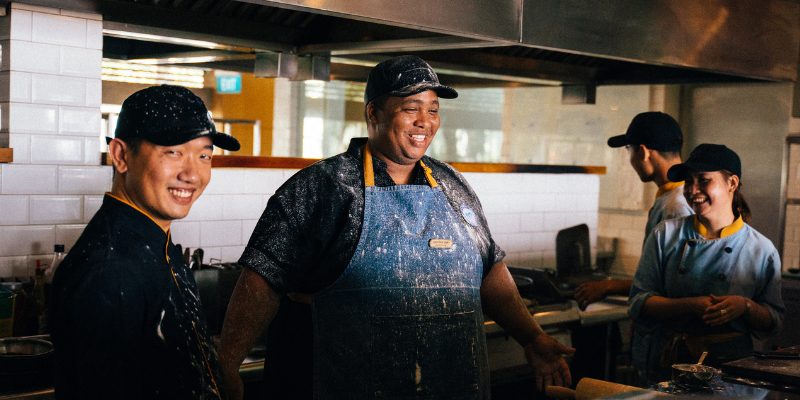As a restaurant owner, staying ahead of the curve when it comes to technology can be a daunting task.
With the rapidly evolving landscape of the food service industry, it’s crucial to keep up with the latest trends and innovations to remain competitive.
Running a restaurant in 2024 means a whole lot more than sourcing restaurant equipment and supplies or local ingredients.
In this blog post, we will explore the top 7 restaurant technologies in 2024 that are revolutionizing the way restaurants operate and interact with customers.
From smart inventory management systems to virtual reality training programs, these cutting-edge technologies are shaping the future of the restaurant industry.

Smart Inventory Management Systems
In the fast-paced world of restaurant management, staying efficient and minimizing waste are keys to success.
Smart inventory management systems are first on the list of the top 7 restaurant technologies in 2024, harnessing the power of cutting-edge technology to streamline the process of tracking and managing stock.
These systems employ a combination of sensors and advanced data analytics to provide real-time insights into inventory levels, significantly reducing the risk of human error and the time traditionally spent on manual counts.
By integrating with suppliers’ databases, these smart systems can automate ordering processes, ensuring that restaurants maintain optimal stock levels without the risk of overordering or running into unexpected shortages.
This automation not only helps in reducing waste but also aids in managing cash flow more effectively, a critical aspect of any restaurant’s profitability.
Predictive analytics is another groundbreaking feature of these systems.
By analyzing historical data, they can forecast future demand with a high degree of accuracy, taking into account various factors such as seasonal trends, local events, and even weather forecasts.
This allows restaurant owners to make informed decisions about menu planning and special promotions, further optimizing inventory use and reducing costs.
Additionally, smart inventory management systems facilitate a more strategic approach to supplier negotiation and selection.
With comprehensive data on hand, restaurants can assess supplier performance, compare costs, and ensure they are getting the best value for their money.
This level of insight is invaluable in today’s competitive market, where every dollar saved can be reinvested into enhancing the customer experience or expanding the business.
In essence, smart inventory management systems represent a paradigm shift in how restaurants approach the complex task of inventory management.
By leveraging these technologies, owners can focus more on delivering exceptional dining experiences and less on the logistics of stock management, setting the stage for greater efficiency and success in the modern restaurant industry.
Integrated POS and Payment Solutions
As the digital age continues to redefine every aspect of the restaurant industry, the emergence of integrated POS and payment solutions in 2024 stands out as a beacon of operational excellence and customer satisfaction.
This innovative fusion of technology not only streamlines the transaction process but also enhances the overall efficiency of service delivery.
With these systems in place, restaurants can offer a smoother, more engaging dining experience, thereby elevating customer satisfaction to new heights.
The integration of POS systems with sophisticated payment solutions facilitates a multitude of conveniences, including contactless payments, mobile transactions, and instant bill splitting, which cater to the evolving preferences of today’s tech-savvy diners.
These platforms support a variety of payment methods, ensuring that every customer’s preference is accommodated, from traditional credit cards to the latest digital wallets.
This versatility in payment options significantly reduces wait times and simplifies the checkout process, allowing guests to conclude their dining experience on a high note.
Moreover, this technology empowers restaurant staff with actionable insights and data-driven recommendations, enabling personalized service that anticipates the diner’s needs.
Through the collection and analysis of transactional data, these integrated systems can identify customer behavior patterns, menu item preferences, and peak dining times, thereby assisting restaurant owners in making informed decisions that drive revenue growth and operational efficiency.
By adopting integrated POS and payment solutions, restaurants not only modernize their operational capabilities but also position themselves at the forefront of a competitive market.
This technological advancement represents a critical step forward in achieving a seamless blend of convenience, speed, and personalized service that today’s consumers increasingly demand.
In the ever-evolving landscape of the restaurant industry, embracing such innovations is key to captivating customers and cultivating loyalty in the digital era.

AI-Powered Customer Service Platforms
The realm of customer service within the restaurant industry is undergoing a transformative shift, thanks to the integration of artificial intelligence.
AI-powered customer service platforms are leading the charge in revolutionizing how restaurants interact with and serve their patrons.
These sophisticated systems utilize a blend of machine learning algorithms and natural language processing to offer an unprecedented level of personalization and efficiency in customer service operations.
One of the standout features of these platforms is their ability to harness vast amounts of customer data to predict preferences and tailor interactions accordingly.
This capability enables restaurants to provide recommendations based on previous orders, dietary restrictions, and even the time of day, thereby elevating the customer experience to a whole new level.
By analyzing individual customer behaviors and patterns, AI platforms can craft personalized marketing messages and promotions, directly impacting customer engagement and retention.
The deployment of chatbots and voice assistants as part of these AI platforms further underscores the industry’s shift towards automation and efficiency.
These tools are adept at handling a range of customer inquiries, from reservation bookings to menu questions, without the need for direct human intervention.
This not only enhances the speed and quality of service but also allows restaurant staff to allocate more time to tasks that require a personal touch.
Another significant benefit of AI-powered customer service platforms is their role in operational analytics.
By providing real-time feedback on customer interactions and satisfaction levels, these systems offer valuable insights that can inform service improvements, menu adjustments, and even staff training programs.
This data-driven approach ensures that restaurants can swiftly adapt to changing customer expectations and maintain a competitive edge in the bustling marketplace.
In sum, AI-powered customer service platforms are reshaping the landscape of restaurant customer service, offering a synergy of personalization, efficiency, and data-driven decision-making that promises to redefine the dining experience for customers and restaurant owners alike.
Sustainable Food Sourcing Technologies
In the modern culinary world, the emphasis on sustainability and responsible sourcing is not just a trend—it’s a commitment to the planet and future generations.
As restaurants strive to meet this commitment, innovative sustainable food-sourcing technologies have emerged as key players in ensuring transparency and ethical practices in the supply chain.
These restaurant technologies are reshaping how operators source their ingredients, ensuring that every step from farm to table adheres to the highest standards of environmental and social responsibility.
Blockchain technology, for instance, is making significant strides in this area by offering a secure and immutable ledger for tracking the journey of food products.
This level of traceability guarantees that restaurants and their customers can verify the origin, journey, and handling of ingredients, fostering a trust that goes beyond mere assurances.
It enables consumers to support establishments that align with their values, promoting a culture of conscious consumption.
Moreover, traceability apps and platforms are integrating with these blockchain systems to provide real-time data on the sustainability credentials of food suppliers.
By accessing detailed information about farming practices, carbon footprint, and fair trade certifications, restaurants can make informed decisions that align with their sustainability goals. This not only enhances their brand reputation but also encourages a shift in the industry towards more ethical sourcing practices.
Additionally, artificial intelligence is playing a crucial role in optimizing supply chains for sustainability.
AI algorithms can analyze vast amounts of data to identify the most eco-friendly suppliers, predict the environmental impact of sourcing decisions, and suggest alternatives that minimize waste and reduce carbon emissions.
As sustainable food sourcing technologies continue to evolve, they offer restaurants the tools to not only meet the growing demand for ethical and responsible dining options but also lead the charge in transforming the global food system into one that values sustainability at its core.
Advanced Kitchen Automation Tools
The landscape of restaurant kitchen suppliers is being dramatically reshaped by the advent of advanced kitchen automation tools.
These sophisticated technologies are designed to streamline operations, enhance efficiency, and guarantee consistent culinary results, thereby addressing some of the industry’s most pressing challenges.
Among the myriad of innovations, robotic cooking assistants and intelligent cooking appliances stand out for their ability to perform tasks with precision and speed unmatched by human hands.
Robotic cooking assistants, equipped with advanced sensors and machine learning capabilities, can replicate intricate cooking techniques, ensuring that each dish meets high standards of quality and consistency.
This not only elevates the dining experience for patrons but also significantly reduces the margin for error during busy service periods.
Similarly, smart ovens and automated cooking stations are capable of adjusting temperatures and cooking times for optimal results, further streamlining kitchen operations.
These automation tools are not merely about replacing human effort but rather augmenting it.
By taking over routine and time-consuming tasks, they free up culinary staff to focus on innovation and creativity, allowing chefs to experiment with new recipes and presentation styles without the constraints of traditional kitchen processes.
Furthermore, the integration of these technologies into restaurant kitchen equipment workflows can lead to considerable savings in labor costs and reduce the likelihood of workplace injuries, making them a prudent investment for forward-thinking restaurateurs.
By harnessing the power of kitchen automation tools, restaurants are not only able to enhance their operational efficiency but also create a more dynamic and innovative culinary environment.
This marks a significant step forward in the quest for excellence in the restaurant industry, promising a future where technology and culinary artistry coalesce to redefine the boundaries of dining experiences.

Dynamic Menu Pricing Software
In the bustling and ever-evolving landscape of the restaurant industry, dynamic menu pricing software emerges as a groundbreaking tool, poised to redefine the strategy behind menu pricing.
By leveraging the power of data analytics and AI, this technology offers the capability to adjust menu prices in response to a variety of factors including real-time demand, ingredient cost fluctuations, and even weather conditions.
This sophisticated approach to pricing allows restaurant owners to optimize their revenue on a day-to-day basis, adapting swiftly to market dynamics.
The software’s algorithms analyze historical sales data alongside current market trends to forecast demand levels for different dishes.
This enables restaurants to strategically adjust their prices, potentially increasing the price of high-demand items or offering promotions on slower-selling dishes to balance sales and reduce waste.
Additionally, by monitoring competitor pricing and local economic indicators, the software ensures that pricing strategies remain competitive yet profitable, attracting customers without sacrificing margins.
Crucially, dynamic menu pricing software offers the agility needed in the modern dining environment, where consumer preferences and behaviors can shift rapidly.
It empowers restaurants to implement pricing adjustments seamlessly, without the need for time-consuming analysis or manual updates to menu boards.
This not only enhances operational efficiency but also contributes to a more personalized dining experience, as prices can reflect the most current and relevant conditions affecting the restaurant and its patrons.
In a marketplace where agility and data-driven decision-making are paramount, dynamic menu pricing software stands as a key technology for restaurants aiming to thrive in 2024.
Virtual Reality Training Programs
Though it is listed last on our list of the top 7 restaurant technologies in 2024, virtual reality (VR) training programs are revolutionizing staff training within the restaurant industry, providing a highly immersive and interactive learning platform.
These cutting-edge programs enable employees to navigate through detailed simulations of their working environment, offering a unique opportunity to hone their skills without the pressure of real-world consequences.
Whether it’s mastering the art of table service, perfecting kitchen procedures, or managing customer interactions, VR training offers a wide range of scenarios tailored to meet the specific needs of a restaurant’s operations.
This approach to training not only accelerates the learning curve for new staff but also allows for the continuous development of existing employees, ensuring that everyone can adapt to the latest service standards and operational techniques.
The use of VR for training purposes embodies a significant advancement in educational methods, providing a safe, effective, and engaging way for staff to achieve excellence in their roles, thereby directly contributing to the overall customer experience and operational efficiency of the establishment.